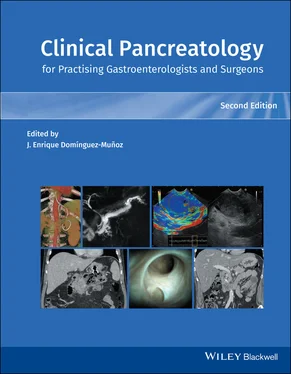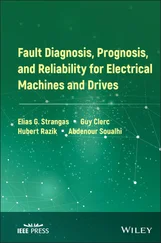Source : adapted from Munigala et al. [81].
| Patient: alcohol and substance abuse Increased comorbidities (increasing Charlson comorbidity index) Severe pancreatitis: association with pseudocyst, necrotizing pancreatitis Discharge to extended care facility (not home discharge) Biliary pancreatitis not undergoing cholecystectomy on initial admission: note that cholecystectomy on index admission for acute biliary pancreatitis reduces rates of readmission |
The Dutch Pancreatitis Study Group followed more than 600 patients after an episode of AP and found that recurrent pancreatitis developed in 117 (17%). This was more common in those with alcoholic or idiopathic or other etiologies compared with biliary disease. In addition, recurrent pancreatitis was more common in smokers and those who had experienced necrotizing pancreatitis. They reported that smoking was the most important factor for recurrent acute pancreatitis (RAP) [83]. The severity of recurrent compared with initial episodes of AP was reported by Lee et al. [84] and Mallick et al. [85]. Lee et al. found that RAP was associated with zero mortality compared with 4.7% mortality in initial episodes. Prior AP episodes had a decreased risk of severe disease (i.e. multisystem organ failure) [84]. This observation may be due to destruction of acinar cells with their replacement by pancreatic fibrosis. Mallick et al. confirmed these observations in a group of 632 patients with an initial episode of AP. Severe pancreatitis, surgical intervention, and mortality were less in patients with RAP compared to patients with an initial episode of AP [85].
Biliary disease is the leading cause of AP in Western countries, and therefore cholecystectomy is the optimal therapy. However, the timing of laparoscopic cholecystectomy in patients with acute biliary pancreatitis has been a contentious issue. The concern of performing same‐admission, so‐called early, cholecystectomy is safety and prolonged length of stay. Conversely, issues associated with delayed laparoscopic cholecystectomy include when it should be performed post AP and determining the risks of recurrent AP and the occurrence of biliary events (i.e. colic, cholecystitis) in the interim. In addition, this timing issue only applies in patients with mild and possibly moderate AP as it is felt that patients with severe disease should undergo cholecystectomy once they recover from their organ failure. There is no consensus about the timing of cholecystectomy in patients with pancreatic necrosis with or without infection. Da Costa et al. [86] reported a randomized controlled trial comparing same admission versus delayed (so‐called interval) cholecystectomy for patients with mild gallstone pancreatitis. The risk of recurrent gallstone‐related complications occurred more frequently (17% in the delayed group vs. 5% in the early group). A systematic review by Lyu et al. [87] of 1833 patients found that gallstone‐related complications occurred in 25% of patients during the waiting period in the delayed cholecystectomy group.
The goal of cholecystectomy is prevention of recurrent AP and biliary events. Multiple societies have recommended cholecystectomy be performed during the initial admission rather than after discharge to prevent occurrence of these events [61]. Bilal et al. [88] reported the trends of same‐admission cholecystectomy in the United States and found a decrease in use of the procedure, from 48.7% in 2004 to 45% in 2014. Delayed cholecystectomy was found to be more common in patients with severe pancreatitis, sepsis, three or more Elixhauser comorbidities, and admission to small or rural hospitals [89] and in older patients [90]. Delayed cholecystectomy in these patients was likely related to the presence of severe pancreatitis with severe comorbidities. In these patients, as always, we must balance risks and benefits of early cholecystectomy.
A concern of early cholecystectomy is whether it is associated with increased operative complications (i.e. conversion of laparoscopy cholecystectomy to open cholecystectomy). Van Baal et al. [91] from the Dutch Pancreatic Group reported a systematic review and found no differences in operative complications, conversion to open cholecystectomy, or mortality between early (index) cholecystectomy and interval cholecystectomy. A follow‐up question in patients with mild acute biliary pancreatitis who are not undergoing early cholecystectomy is whether they should undergo ERCP with ES to prevent readmissions from RAP and biliary events. Ridtitid et al. [92] found that ERCP/ES performed in a delayed cholecystectomy group of AP patients was associated with a significantly lower rate of acute recurrent biliary pancreatitis (4% vs. 36% of those patients not undergoing ERCP/ES). ERCP/ES was associated with the occurrence of mild pancreatitis (4%) and with post‐sphincterotomy bleeding (5%). Bakker et al. [93] reported similar findings: in patients with mild biliary pancreatitis who did not have index cholecystectomy but underwent ERCP/ES, the procedure significantly decreased the occurrence of interval biliary events to 7.4% (compared with 18.4% in those who did not undergo ERCP/ES). This was primarily due to a reduced risk of biliary pancreatitis. Thus, ES is a temporizing measure in patients who are unfit for surgery. ES does not protect totally against biliary colic or acute cholecystitis [93]. The next issue is whether the patients who undergo ERCP/ES should subsequently undergo cholecystectomy, which could further decrease this 7.4% rate of biliary events. Zargar et al. [94] reported a randomized trial of cholecystectomy versus expectant management in patients with biliary AP who had undergone ERCP/ES and found that cholecystectomy significantly reduced the biliary complications in these high‐risk patients. Similar findings were reported by Khan et al. [95] in a systematic review and meta‐analysis that compared early cholecystectomy versus a “wait‐and‐watch” strategy after ES in high‐risk patients. They recommended that patients undergo laparoscopic cholecystectomy because it is associated with lower rates of subsequent recurrent cholecystitis, cholangitis, and biliary colic.
The morbidity of a bout of AP persists in some patients after recovery. Long‐term assessment is addressed in Table 1.8. An episode of AP increases a patient’s risk of developing diabetes mellitus, progressing to chronic pancreatitis with EPI, and is associated with an increased risk of harboring or developing pancreatic cancer. Ventre et al. [96] reported that patients who had severe AP that required critical care were found to have a high risk for developing new‐onset diabetes mellitus. In addition, as expected, greater pre‐hospitalization comorbidity, as determined by the Charlson score, negatively influenced survival. Das et al. [97] conducted a systematic review of diabetes mellitus prevalence after AP and found pre‐diabetes mellitus in 16%; this is important, as 40% of patients with pre‐diabetes progress to diabetes over 5–10 years. Diabetes mellitus was found in 23% and requirement for insulin treatment in 15%. Newly diagnosed diabetes (so‐called type 3c diabetes) developed in 15% within 12 months after the first episode of AP. Interestingly, they found that there was no effect of disease severity on the risk of developing diabetes mellitus. Conversely, in a study of patients who had severe pancreatitis, of whom almost three‐quarters underwent open necrosectomy, new‐onset diabetes mellitus was found in 45%, and pancreatic insufficiency requiring pancreatic enzyme replacement was found in 25% [98].
Shen et al. [99] reported a cohort study that included almost 3000 patients with their first attack of AP and approximately 12 000 individually matched controls. The incidence of developing diabetes within the first three months after AP was 60.8 per 1000 person‐years in the AP group compared with 8.0 per 1000 person‐years in the control group (hazard ratio, HR, 5.9). The adjusted HR was 2.54 for developing diabetes mellitus beyond three months. Similar to other studies, the results for patients with mild AP were similar to those for all AP groups. We should therefore be aware that after AP of all severities, the risk of developing diabetes mellitus is increased, so‐called “diabetes of the exocrine pancreas” [100].
Читать дальше












